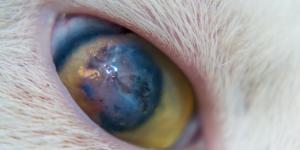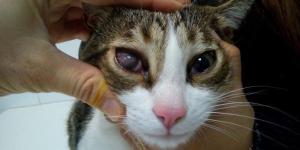Cat Eye Diseases - Types, Causes, Symptoms and Treatment



See files for Cats
Are you wondering which are the most common cat eye diseases? If so, you’ve come to the right place. Most cat eye diseases and problems can be treated, but in most cases veterinary attention is necessary. If not treated, cat eye diseases can cause irreversible damage and can even result in blindness. In some more serious cases, lack of treatment or care can even be cause for the affected eye(s) to be removed.
For more about treatment, symptoms and causes of common cat eye diseases, keep reading here at AnimalWised. In addition, we will be listing the most common eye diseases in cats so that you know what to look out for and how to avoid them!
- Common cat eye diseases: list
- Cat eye disease: corneal ulcers in cats
- Cat eye problems: dendritic corneal ulcers in cats
- Cat eye diseases: conjunctivitis in cats
- Cat eye diseases: feline uveitis
- Cat eye infection: feline glaucoma
- Cat eye disease: excessive tearing in cats
- Eye infection in kittens
- Cat eye infection: home remedy
Common cat eye diseases: list
Cat eye diseases are characterized by excessive secretion, tearing, redness or inflammation, among other symptoms. These signs may be associated with different health problems, some of a viral nature, bacterial and/or as a result of foreign objects or trauma. The most common eye diseases in cats include:
- Corneal ulcers.
- Dendritic ulcers.
- Conjunctivitis.
- Uveitis.
- Glaucoma.
- Obstruction in the nasolacrimal duct.
In the following sections we will discuss symptoms of each of these cat eye diseases as well as possible treatments.
Cat eye disease: corneal ulcers in cats
Corneal ulcers in cats are very common and its severity depends on the depth of its damage. Treatment will also vary depending on the cause of the type of ulcer. Cat eye ulcers are extremely painful and the appearance of the cornea will be modified.
The most common causes of corneal ulcers in cats include trauma, such as scratches, foreign bodies, hair that grows out and rubs the eye, bacterial infections, etc. Causes of corneal ulcers in cats also include feline herpesvirus (FHV, FHV-1), which we will elaborate on in the following sections.
Symptoms of corneal ulcers in cats include:
- Squinting.
- Light sensitivity.
- Inflamed and red eyes.
- Discharge.
- Scratching.
- Cloudy eyes.
Veterinarians often reach a diagnosis by applying fluorescein to the affected eye or, in the case of more superficial ulcers, a pigment called Rose Bengal. As we’ve already mentioned, treatment will depend on the cause. Corneal ulcers in cats treatment must be administered quickly to avoid perforation of the cornea. Serious cases of corneal ulcers in cats may require surgery. For more, we recommend reading our article where we discuss, why are my cat eyes red?

Cat eye problems: dendritic corneal ulcers in cats
This type of corneal ulcer in cats is more common in stray cats, as it is caused by the feline herpesvirus (FHV) which is caused by feline rhinotracheitis[1]. The feline herpesvirus is extremely contagious among cats that live in collectives. Among the most common eye infections in cats is rhinotracheitis, responsible for intense ocular secretion. Rhinotracheitis is more common among kittens. For more, we recommend reading our article where we discuss everything you need to know about feline infectious rhinotracheitis.
Although these ulcers are mild, the virus can cause deeper ulcers that, without treatment, could perforate the cornea which can result in eye removal. Sick cats suffering from rhinotracheitis are more prone to dendritic corneal ulcers. These ulcers are usually accompanied by conjunctivitis and appear in one or both eyes.

Cat eye diseases: conjunctivitis in cats
Conjunctivitis in cats is extremely common, especially among kittens. Although it can originate from foreign objects in the eye(s) it is usually also associated with the feline herpesvirus, even in cases in which the cat does not manifest other symptoms.
Conjunctivitis symptoms in cats are characterized by their bilateral presentation, with ocular redness, an abundant purulent discharge that reaches the eyelids when dried. In cases of rhinotracheitis, it is accompanied by a respiratory disease. Conjunctivitis in cats requires veterinary consultation, with treatment and antibiotics. For more, we recommend reading about the most common diseases in cats.
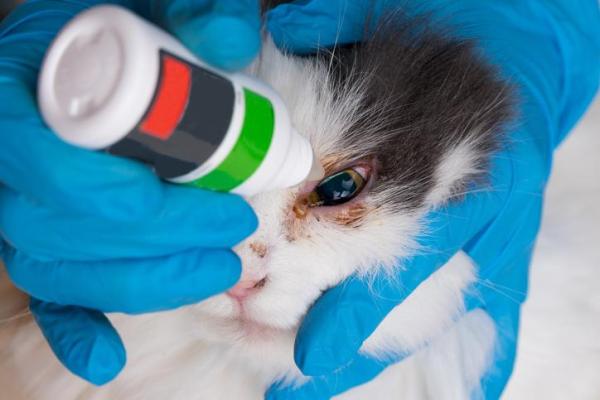
Cat eye diseases: feline uveitis
Feline uveitis is a common symptom of several pathologies. Although, other times, it is related to traumas due to fights. Causes of feline uveitis include:
- Toxoplasmosis
- Feline leukemia
- Immunodeficiency
- Cat PIF (Feline infectious peritonitis)
- Mycoses
- Bartonellosis (Bartonella)
- Feline herpesvirus, etc.
Some of these diseases are potentially fatal, therefore veterinary attention is very important! In addition, feline uveitis treatment will depend on the cause.
Severity of feline uveitis can vary, depending on the structures involved; distinguishing between anterior, intermediate and posterior uveitis. Symptoms of feline uveitis include:
- Pain
- Photophobia
- Intense lacrimation
- Protrusion of the third eyelid (the eye will appear smaller).
Treatment is oriented towards the cause of the uveitis as well as controlling its symptoms. For more, keep reading, why does my cat have dilated pupils?
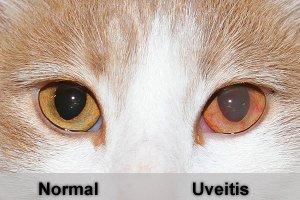
Cat eye infection: feline glaucoma
Feline glaucoma can have several different causes with one thing in common, there is an increase in intraocular pressure to produce more aqueous humor than is eliminated. This process damages the optic nerve and can cause blindness.
Luckily, glaucoma is not very common in cats and, if it does occurs, it does so in cats over 8-9 years of age. In addition, it is usually associated with uveitis, neoplasms, trauma, etc. Feline glaucoma treatment will depend on the pathology causes it.
When glaucoma causes pain, enlargement of the eyeball or pupil dilation, it is likely that the eye is already blind. Diagnosis is based on the measurement of intraocular pressure. Treatment involves identifying the cause and prescribing medication to reduce pain and pressure inside the eye.
You may also find out article about adopting a blind cat and what to consider interesting.
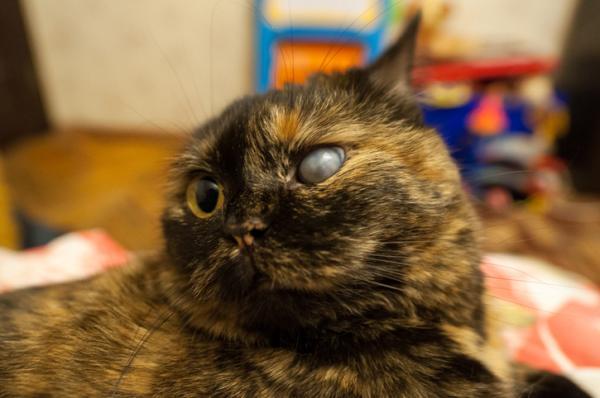
Cat eye disease: excessive tearing in cats
Cat eye discharge or watery eyes in cats is a clear sign of eye problems in cats. This lacrimation may be due to a foreign object. If, however, it does not remit after time, it could indicate an obstruction in the nasolacrimal duct resulting in epiphora. Nasolacrimal duct obstruction in cats means that tears can’t drain normally, therefore, it leads to irritated and watery eyes. Nasolacrimal duct obstruction in cats is often temporary, due to an infection or inflammation. If permanent, the cat is usually born with it. This eye disease is more common in brachycephalic breeds such as Persian cats.
Are your cat’s eyes constantly watering? If so, contact your veterinarian as treatment will depend on the cause. For more, read about why does my cat have so many eye boogers?

Eye infection in kittens
Kittens are born with their eyes closed and begin to open them at around eight days of age. But its important to know that a kitten can suffer from an eye infection even when its eyes are closed. In these such cases you will notice that both eyes will be visible swollen. If you push gently on the eye you may even notice pus secreting from between the eyelids. You may also notice crusting from when the pus dries out. You should clean these crusts gently with a gauze or cotton pad moistened in saline or lukewarm water.
If you notice a kitten eye infection, you should go to the veterinarian immediately, especially due to the fact that feline herpesvirus is more common in kittens. A veterinarian will likely prescribe antibiotic treatment that will have to be applied by separating the eyelids gently. For more, we recommend reading out article about cleaning the eyes of a cat.
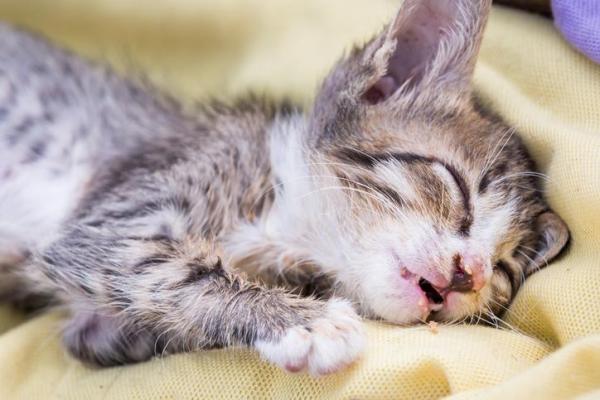
Cat eye infection: home remedy
As we’ve mentioned above, most of these eye diseases in cats need to be diagnosed correctly by a professional in order to treat it accordingly. However, in some cases, you should know how to treat your cat’s eyes in case of infection. For more, read cat eye infection treatment.
This article is purely informative. AnimalWised does not have the authority to prescribe any veterinary treatment or create a diagnosis. We invite you to take your pet to the veterinarian if they are suffering from any condition or pain.
If you want to read similar articles to Cat Eye Diseases - Types, Causes, Symptoms and Treatment, we recommend you visit our Eye problems category.


